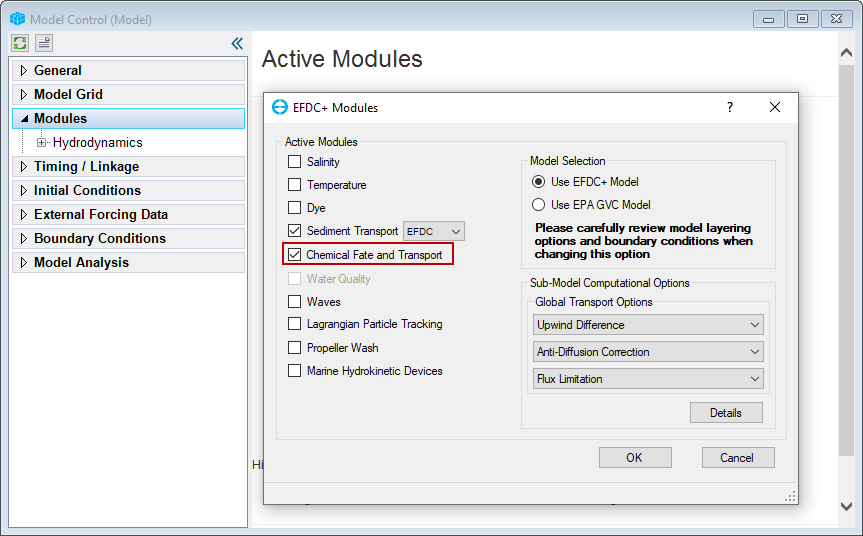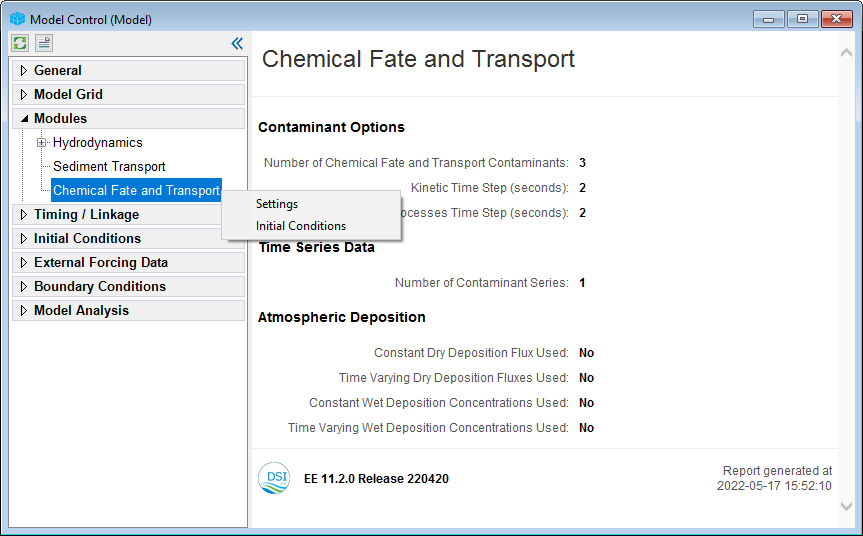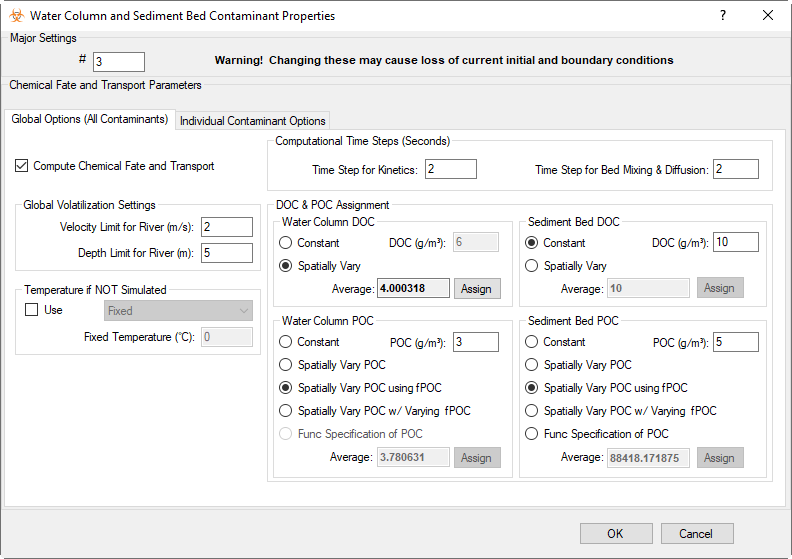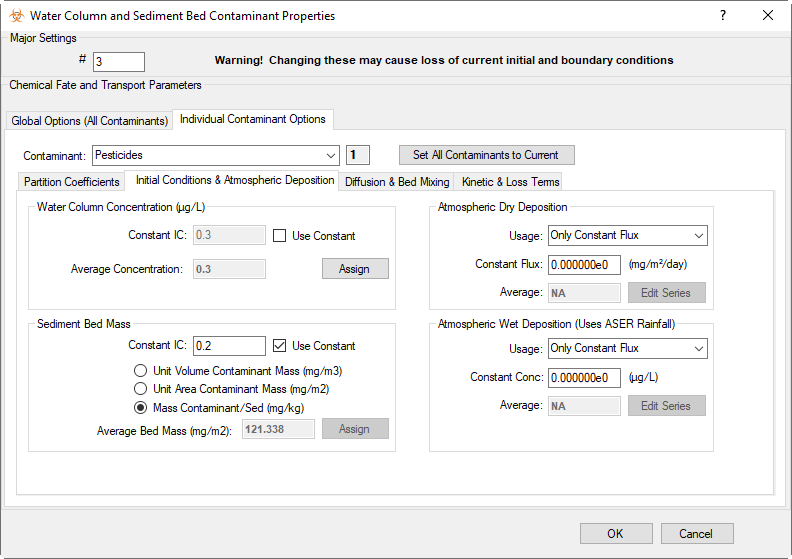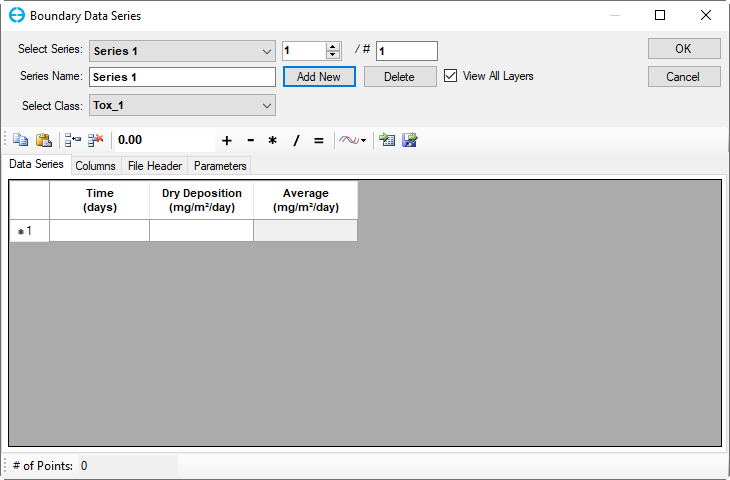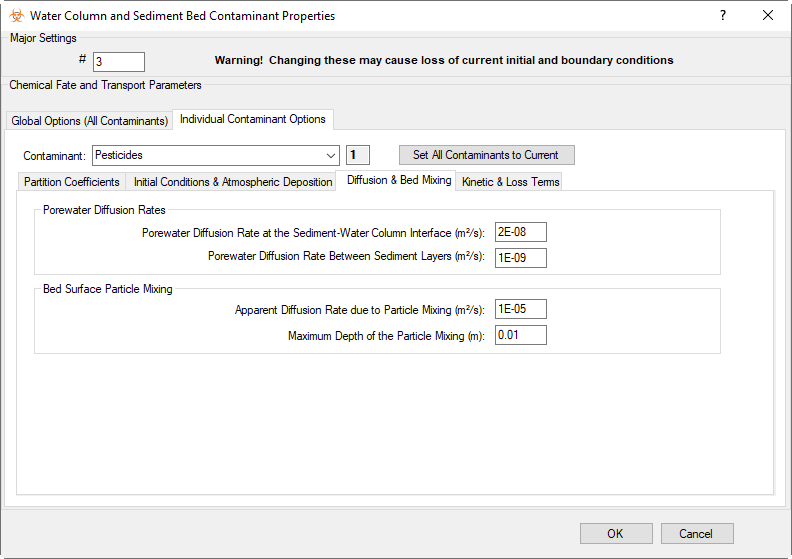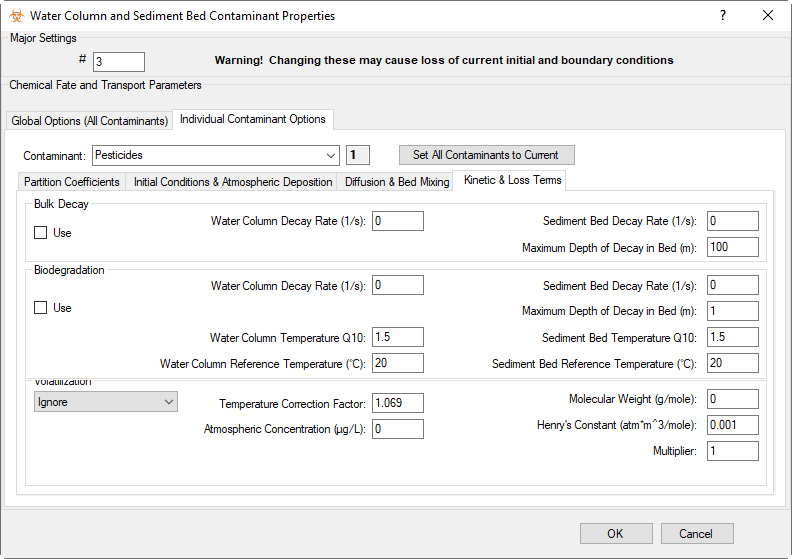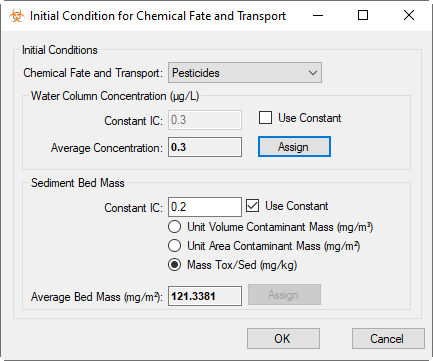Chemical Fate and Transport
Activate the Chemical Fate and Transport Module
To activate the Chemical Fate and Transport module, the Sediment Transport module also needs to be activated, as shown in Figure 1.
Figure 1. Active Chemical Fate and Transport Modules.
The Chemical Fate and Transport menu item provides the user with a report of the current setting with an LMC, as shown in Figure 2 and two options Settings and Initial Conditions.
Figure 2. Model Control: Chemical Fate and Transport Module.
Settings
When LMC on Settings, the Water Column and Sediment Bed Contaminant Properties frame is displayed as shown in Figure 3. In this frame, you can define the number of contaminants in the Major Settings text box. This can be changed by the user, but since boundary and initial conditions are predicated on the number of contaminants, changing this value resets many of the inputs. Therefore, this should only be changed when the user is prepared to reset all the initial and boundary conditions. A special case here is if the user sets the number to 0; then the contaminant inputs are skipped for that project from that time forward.
In the Chemical Fate and Transport Parameters frame, select Global Options (All Contaminants) tab, check on the Computed Chemical Fate and Transport checkbox. This tab is global settings for all contaminants.
Here the user should assign the Global Volatilization Settings if simulating a river. In cases where the temperature is not being simulated in the model, use the Temperature if NOT Simulated frame options to set a fixed temperature. The Computational Time Step (Second) may also be set in the respective frame.
The Initial Conditions Options frame provides settings for ICs for all contaminants for constant water column and bed; spatially varying water column (requires TOXW.INP file); spatially varying bed conditions (requires the TOXB.INP file); and spatially varying for both bed conditions and water column (requires both TOXW.INP and TOXB.INP). If a constant water column initial condition is being used, then the text box under Water Column Constant IC frame is available. If a spatially varying water column is used, then this option is greyed out. In the case that spatially varying water column options are being used, the user should use the Assign button under Initial Conditions on the main form to set the varying water column values.
The DOC & POC Assignments tab frame is also shown in Figure 3. The Water Column DOC may be set to a constant or to vary spatially, in which case the user should use the DOCW.INP file to assign the constant time–spatially varying DOC. If the Sediment Bed DOC is set to be spatially varying, then the user must use the DOCB.INP file to assign the constant time–spatially varying DOC.
In the case of the Water Column POC, if set to Spatial Varying POC the user should use the POCW.INP file to assign the constant time–spatially varying POC. The Spatially Vary POC with fPOC option uses WC Seds and fPOC (Seds). The spatially varying POC/fPOC option uses WSeds and spatially varying fPOC from the FPOCW.INP file.
In the Sediment Bed POC frame, if set to Spatial Vary POC the user should use the POCB.INP file to assign the constant time–spatially varying POC. The Spatially Vary POC with fPOC option uses the bed sediments and fPOC (bed). The spatially varying POC/fPOC option uses WCSeds and spatially varying fPOC from the FPOCB.INP file. The Functional Specification of POC option means the user must modify the EFDC subroutine SETFPOCB to set POC in the bed.
Figure 3. Chemical Fate and Transport Settings.
Click on the Individual Contaminant Options tab for setting of each toxic contaminant as shown in Figure 4. Once a contaminant has been selected, all the appropriate information is displayed on the form. The Contaminant Name field is only used by EFDC+ Explorer for labeling and information.
The series of tabs allow the user to define the toxic contaminant parameters in detail. In the Partition Coefficients tab as shown in Figure 4, the user should select the Sorption Model to be implemented from the radial buttons available, which include: Kd (Non-OC based); DOC & POC (Class Independent); DOC and POC. POC =(foc*SED) by class; and POC only. POC =(foc*SED) by class. The contents of the grid (i.e., field) will change based on the partitioning model selected. For partitioning model 3 (DOC and POC. POC =(foc*SED) by class) and model 4 (POC only. POC =(foc*SED) by class), there are two options for the user to set the POC and DOC value. If the user selects Constant radial button, then EE will save and read the value for DOC and POC directly from the WC Partition Coeff (l/mg) and Bed Partition Coeff (l/mg) for each class in parameter table. Otherwise, if the user selects the Spatially Varying radial button, then the Assign button will enable to allow the user to set the varying values of POC and DOC for each cell and each sediment class. The spatially varying coefficient will be saved to the PARTITIONW.INP file for WC partition coefficient and PARTITIONB.INP file for bed partition coefficient. Note that if the value of WC partition coefficient or bed partition coefficient in any class is negative, EE will change the option to Spatially Varying and read the value from PARTITIONW.INP or PARTITIONB.INP respectively.
The partitioning factors and the concentration factors units must be consistent. Typical units for the toxic concentrations are mg/kg or μg/kg.
Figure 4. Settings: Individual Contaminant Options.
The Initial Conditions & Atmospheric Deposition tab is shown in Figure 5. The initial conditions option for all contaminants is set here for both Water Column Concentration and Sediment Bed Mass, which is based on IC Options from Global Option tab.
If the user selects a constant value in the IC Options frame, then they can type in the value of WC and Bed Toxic ICs directly to IC boxes.
If the user selects a spatially varying value, they should click the Assign button, and the form of Apply Cell Properties via Polygons: Toxics is displayed as shown in Figure 6. In this form, the user has different options for assigning initial conditions of the contaminant in the water column from a constant value or data file.
Figure 5. Individual Contaminant Options: Initial Condition Options.
Figure 6. Water Column IC Toxics Assignment.
EEMS also allows for dry and wet atmospheric deposition. Two approaches are available for both dry and wet deposition. First, the user can specify a temporally constant dry deposition flux in mg/m2/day and/or they can specify a time series of dry deposition. Although these fluxes are applied over the entire domain, the applied mass flux may vary spatially because the input fluxes are specified based on square meters, so if the cell sizes vary, the applied mass fluxes will also vary.
Atmospheric Dry/Wet Deposition: For these options, select use Only Constant Flux value, Temporally and Varying value or Both Constant and Varying value for atmospheric deposition.
Selecting Only Constant Flux, then enter a value directly to Constant Flux box.
Selecting Temporally and Varying, click on the Edit Series button to open the Boundary Data Series form to create an atmospheric deposition time series as shown in Figure 7 below.
Figure 7. Edit Time Series.
If the selecting Both Constant and Varying option, then we can enter a constant value and create a time series. EFDC+ will add the constant value to the time series data to create the final data series and use that data to simulate atmospheric deposition.
Note that each toxic class only uses one atmospheric dry deposition series and one atmospheric wet deposition series.
The Diffusion & Bed Mixing tab is shown in Figure 8
Figure 8. Diffusion & Bed Mixing.
The Kinetic & Loss Terms tab is shown in Figure 9
Figure 9. Kinetic & Loss Terms.
Initial Conditions
The initial conditions for chemical fate and transport include water column centration and sediment bed mass. Those parameters can be set at a constant value or spatial varying by clicking Assign button.
Figure 10. Initial Condition for Chemical Fate and Transport.
